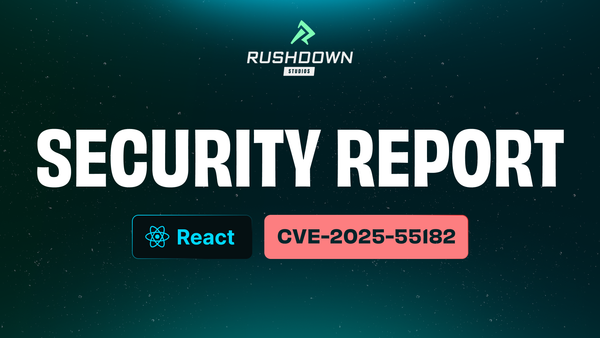Security Report: CVE-2025-55315 in ASP.NET and What It Means for Game Backend Services

If you're running online services for your video game, especially if you're using ASP.NET Core and C#, you need to know about CVE-2025-55315. This critical vulnerability was disclosed on October 14, 2025, and it carries a CVSS score of 9.9, which is nearly the maximum severity rating possible.
Summary
- CVE-2025-55315 ASP.NET Security Feature Bypass Vulnerability
- Weakness: CWE-444: Inconsistent Interpretation of HTTP Requests ('HTTP Request/Response Smuggling')
- Affected Versions: ASP.NET Core versions 8.0, 9.0, and 10.0, ASP.NET Core 2.3 family
- Mitigation: Apply the right Security Updates from Microsoft for you affected versions
Why C# Backend Services Are So Common in Gaming
There's a natural reason why so many game developers end up building their backend services in C# and ASP.NET Core. Unity, one of the most popular game engines in the world, uses C# as its primary scripting language. When Unity developers need to build matchmaking systems, leaderboards, player authentication services, or any other online functionality, they often reach for C# on the backend too. It's the language they already know, the tooling is familiar, and the development workflow feels seamless. This has led to a proliferation of ASP.NET Core services powering everything from indie multiplayer games to major online gaming platforms.
While this tech stack has served the gaming industry well it also means that vulnerabilities affecting ASP.NET Core can have widespread impact across countless gaming services running worldwide. Shodan.io reports that there are about 3.5 million webservers X-Powered-By: ASP.NET .
Understanding CVE-2025-55315: The HTTP Request Smuggling Vulnerability
CVE-2025-55315 is classified as a security feature bypass vulnerability in ASP.NET Core, specifically affecting the Kestrel web server component. At its core, this vulnerability falls under CWE-444: Inconsistent Interpretation of HTTP Requests, commonly known as HTTP Request Smuggling or HTTP Response Smuggling.
To understand why this matters, imagine your game's backend infrastructure like a nightclub with multiple security checkpoints. You have a bouncer at the front door (your reverse proxy or load balancer), and another security checkpoint inside (your ASP.NET Core application). HTTP request smuggling occurs when these two security systems don't speak the same language and they interpret the same HTTP request differently.
An attacker can craft a specially formatted HTTP request that the front-door bouncer sees as one request, but your internal application sees as two separate requests. The second "smuggled" request bypasses all the security checks that the first request went through. This inconsistency happens because of ambiguous or malformed HTTP messages, like duplicate headers, conflicting Content-Length values, or unusual Transfer-Encoding specifications that different systems parse in different ways.
For your game service, this vulnerability is particularly concerning because it affects confidentiality and integrity at a high level. An attacker with even low-level authenticated access could potentially access sensitive player data, manipulate game state, or tamper with server-side logic. The vulnerability affects ASP.NET Core versions 8.0, 9.0, and 10.0, as well as the legacy ASP.NET Core 2.3 family.
How an Attacker Could Exploit This Vulnerability
The exploitation scenario for CVE-2025-55315 is particularly troubling for game services because it doesn't require sophisticated hacking tools or deep system access. It just needs low-level authenticated access and knowledge of HTTP protocol manipulation.
Here's a realistic attack scenario: Imagine a player creates a basic account on your game platform, giving them minimal authenticated access to your services. Using this legitimate account, they craft malicious HTTP requests with ambiguous headers. When these requests pass through your infrastructure, your front-end reverse proxy (like NGINX, IIS, or a cloud load balancer) interprets the request one way, but Kestrel, the ASP.NET Core web server powering your backend, interprets it differently.
The result of this is the attacker successfully "smuggles" a second, unauthorized request past your security controls. This smuggled request bypasses authentication checks, CSRF protections, rate limiting, and other security features that would normally block it.
What could they do with this access? The possibilities are concerning:
- Data Theft: They could access other players' personal information, payment details, or account credentials. In a competitive gaming environment, they might steal proprietary game analytics or player behavior data.
- Game State Manipulation: They could forge authenticated requests to modify game state to award themselves in-game currency, unlocking achievements they didn't earn, or manipulating leaderboards and competitive rankings.
- Privilege Escalation: They could elevate their access from a regular player account to administrative privileges, potentially gaining control over server configurations or other players' accounts.
- Persistent Backdoors: In the worst-case scenario, successful exploitation could allow them to plant web shells or modify server-side scripts, giving them persistent access to your infrastructure even after the initial vulnerability is patched.
The attack is particularly bad because the smuggled requests can appear to come from legitimate, authenticated sessions. Your security logs might show normal traffic patterns while malicious operations occur in the shadows. For game developers, this could mean compromised player accounts, unfair competitive advantages, economic disruption in in-game markets, and severe damage to player trust.
Immediate Action Required
Microsoft has released patches for this vulnerability as part of their October 2025 security update. If you're running ASP.NET Core services for your game:
- Patch immediately: Update your .NET runtime to the latest version or update the Microsoft.AspNetCore.Server.Kestrel.Core NuGet package to version 2.3.6 or later.
- Assess your deployment model: Framework-dependent deployments need runtime updates on your servers. Self-contained applications must be rebuilt with the patched packages.
- Review your infrastructure: If you're running Kestrel directly exposed to the internet (not behind a reverse proxy), you're at higher risk and should prioritize patching.
- Monitor for suspicious activity: Look for unusual request patterns, particularly those involving duplicate headers or unexpected HTTP parsing behavior.
- Consider your hosting environment: If you're using in-process IIS hosting or have internet-facing services, treat these as the highest priority for patching.
Conclusion
CVE-2025-55315 represents a serious threat to game backend services built on ASP.NET Core. The combination of widespread C# usage in gaming (thanks to Unity), the critical nature of the vulnerability, and the potential for significant player impact makes this a top priority for any development team running online services.
Don't wait for an exploit to hit your infrastructure. Patch now, review your security configurations, and ensure your game services are protected against this critical vulnerability. Your players' data, your game's integrity, and your studio's reputation depend on it.




